急性左心衰竭 个案[一类严选]
- 格式:ppt
- 大小:1.63 MB
- 文档页数:6

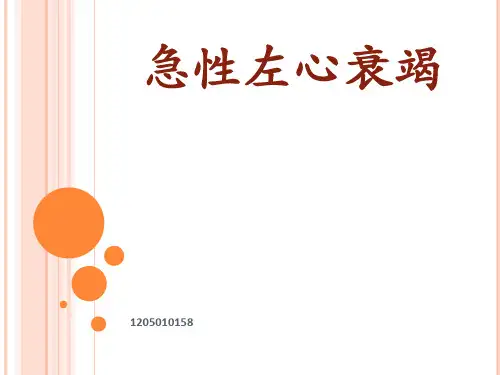
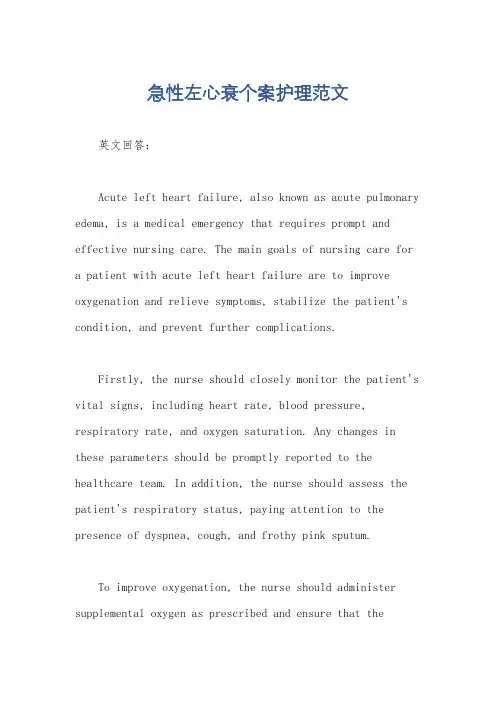
急性左心衰个案护理范文英文回答:Acute left heart failure, also known as acute pulmonary edema, is a medical emergency that requires prompt and effective nursing care. The main goals of nursing care for a patient with acute left heart failure are to improve oxygenation and relieve symptoms, stabilize the patient's condition, and prevent further complications.Firstly, the nurse should closely monitor the patient's vital signs, including heart rate, blood pressure, respiratory rate, and oxygen saturation. Any changes in these parameters should be promptly reported to the healthcare team. In addition, the nurse should assess the patient's respiratory status, paying attention to the presence of dyspnea, cough, and frothy pink sputum.To improve oxygenation, the nurse should administer supplemental oxygen as prescribed and ensure that thepatient is in an upright position to facilitate lung expansion. The nurse should also encourage deep breathing exercises and provide emotional support to help alleviate anxiety and promote relaxation.To relieve symptoms, the nurse should administer diuretics as prescribed to reduce fluid overload and decrease pulmonary congestion. Close monitoring of urine output is essential to assess the effectiveness of diuretic therapy. In addition, the nurse should administer medications to improve cardiac function, such as vasodilators and inotropic agents, as prescribed by the healthcare team.Stabilizing the patient's condition involves maintaining a stable fluid balance and preventing fluid overload. The nurse should closely monitor the patient's intake and output, as well as daily weights, to assessfluid status. Strict fluid and sodium restrictions may be necessary, and the nurse should educate the patient and family members about the importance of adhering to these restrictions.Preventing further complications is crucial in the management of acute left heart failure. The nurse should closely monitor for signs of worsening heart failure, such as increased dyspnea, orthopnea, or peripheral edema. In addition, the nurse should educate the patient and family members about the importance of medication compliance, regular follow-up appointments, and lifestyle modifications, such as a low-sodium diet and regular exercise.In conclusion, nursing care for a patient with acuteleft heart failure involves closely monitoring vital signs and respiratory status, improving oxygenation, relieving symptoms, stabilizing the patient's condition, and preventing further complications. Prompt and effective nursing interventions are essential in managing thismedical emergency.中文回答:急性左心衰竭,也称为急性肺水肿,是一种需要迅速和有效的护理的医疗急症。
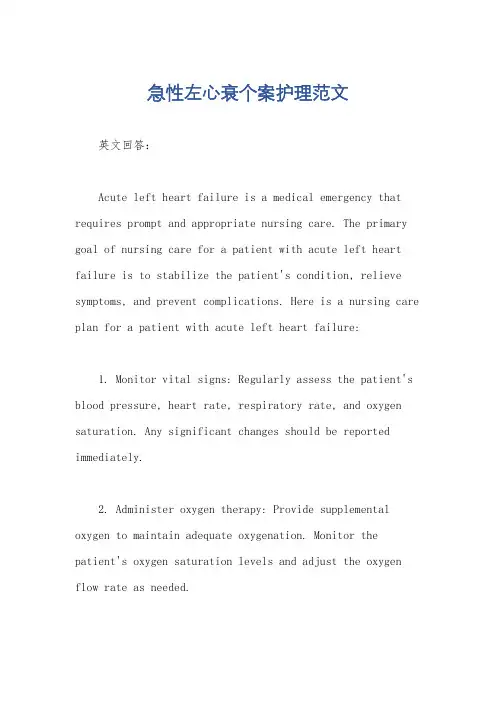
急性左心衰个案护理范文英文回答:Acute left heart failure is a medical emergency that requires prompt and appropriate nursing care. The primary goal of nursing care for a patient with acute left heart failure is to stabilize the patient's condition, relieve symptoms, and prevent complications. Here is a nursing care plan for a patient with acute left heart failure:1. Monitor vital signs: Regularly assess the patient's blood pressure, heart rate, respiratory rate, and oxygen saturation. Any significant changes should be reported immediately.2. Administer oxygen therapy: Provide supplemental oxygen to maintain adequate oxygenation. Monitor thepatient's oxygen saturation levels and adjust the oxygen flow rate as needed.3. Assess respiratory status: Monitor the patient's respiratory effort, breath sounds, and oxygen saturation. Auscultate lung sounds for crackles or wheezes. Administer prescribed bronchodilators or diuretics to relieve pulmonary congestion.4. Monitor fluid balance: Assess the patient's intake and output, including urine output, to evaluate fluid status. Administer diuretics as prescribed to promote diuresis and reduce fluid overload.5. Elevate the head of the bed: Position the patient ina semi-Fowler's position to promote optimal lung expansion and reduce dyspnea.6. Administer medications as prescribed: Administer medications such as vasodilators (e.g., nitroglycerin) or inotropic agents (e.g., dobutamine) to improve cardiac function and reduce preload and afterload.7. Provide emotional support: Assess the patient's emotional status and provide reassurance and support.Encourage the patient to express feelings and concerns.8. Educate the patient and family: Provide education about the condition, including signs and symptoms of worsening heart failure, medication management, andlifestyle modifications such as a low-sodium diet andregular exercise.中文回答:急性左心衰竭是一种需要迅速和适当护理的医疗急症。
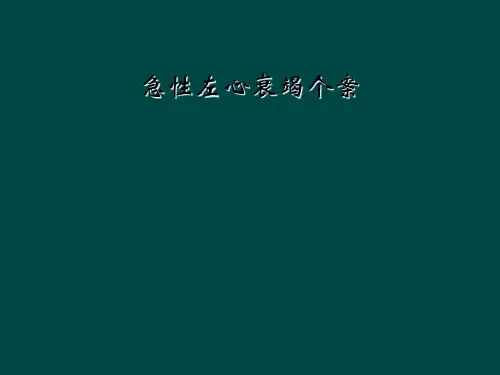

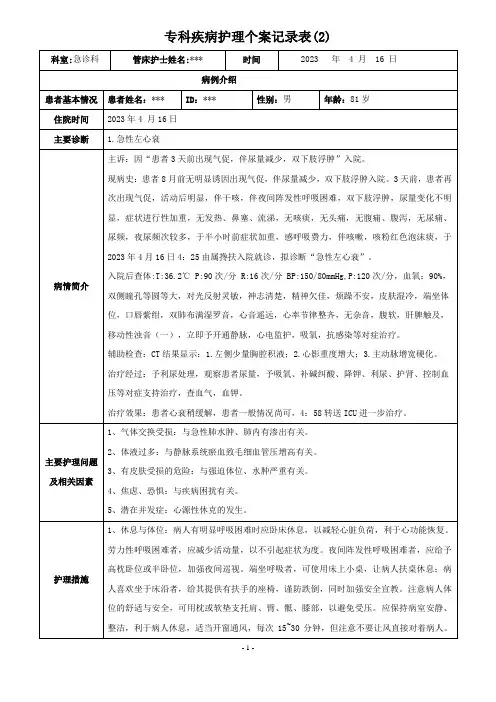
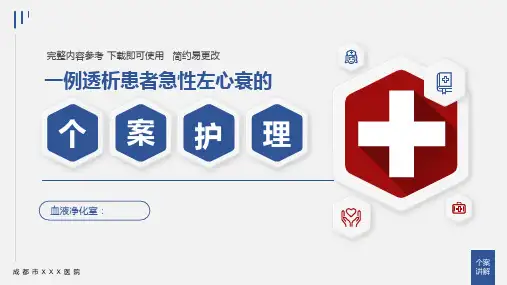

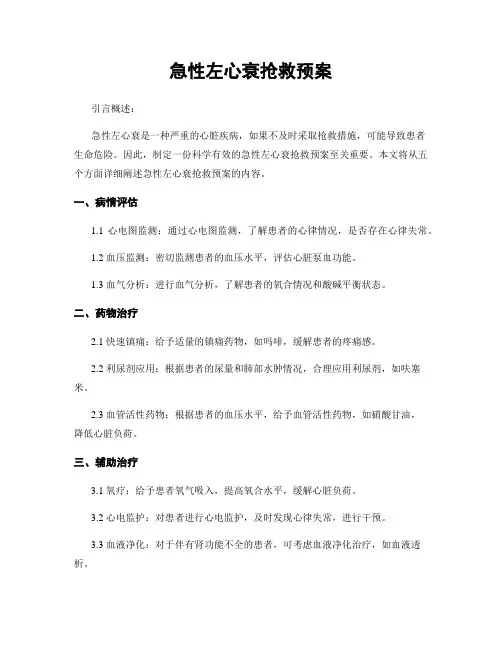
急性左心衰抢救预案引言概述:急性左心衰是一种严重的心脏疾病,如果不及时采取抢救措施,可能导致患者生命危险。
因此,制定一份科学有效的急性左心衰抢救预案至关重要。
本文将从五个方面详细阐述急性左心衰抢救预案的内容。
一、病情评估1.1 心电图监测:通过心电图监测,了解患者的心律情况,是否存在心律失常。
1.2 血压监测:密切监测患者的血压水平,评估心脏泵血功能。
1.3 血气分析:进行血气分析,了解患者的氧合情况和酸碱平衡状态。
二、药物治疗2.1 快速镇痛:给予适量的镇痛药物,如吗啡,缓解患者的疼痛感。
2.2 利尿剂应用:根据患者的尿量和肺部水肿情况,合理应用利尿剂,如呋塞米。
2.3 血管活性药物:根据患者的血压水平,给予血管活性药物,如硝酸甘油,降低心脏负荷。
三、辅助治疗3.1 氧疗:给予患者氧气吸入,提高氧合水平,缓解心脏负荷。
3.2 心电监护:对患者进行心电监护,及时发现心律失常,进行干预。
3.3 血液净化:对于伴有肾功能不全的患者,可考虑血液净化治疗,如血液透析。
四、心脏支持治疗4.1 心脏起搏器:对于伴有严重心律失常的患者,可考虑植入临时或永久性心脏起搏器。
4.2 体外膜肺氧合:对于病情严重的患者,可考虑使用体外膜肺氧合技术,提供临时的心脏支持。
4.3 心脏移植:对于病情极度危急的患者,可考虑进行心脏移植手术,提供长期的心脏支持。
五、后续护理5.1 密切观察:抢救后,患者需要进行密切观察,监测生命体征和病情变化。
5.2 营养支持:给予患者适当的营养支持,维持机体功能恢复。
5.3 康复训练:根据患者的具体情况,制定康复训练计划,促进心脏功能恢复。
总结:急性左心衰抢救预案是一项重要的工作,通过病情评估、药物治疗、辅助治疗、心脏支持治疗和后续护理,可以及时有效地抢救急性左心衰患者,提高其生存率和生活质量。
然而,预防仍然是最重要的,提醒人们注意心脏健康,预防心脏疾病的发生。

急性左心衰的案例护理急性左心衰的案例护理1病例资料刘先生,70岁,有心脏损害病史,突感严峻呼吸困难,端坐呼吸,频繁咳嗽,咯白色或粉红色泡沫痰,烦躁不安,面色惨白,口唇青紫,末梢发绀,大含淋漓,心悸乏力。
体检:T ℃,HR132次/分,R26次/分,BP130/75mmHg。
双肺布满湿罗音及哮鸣音,心尖部可闻及奔马律。
实验室检查:①X线可见肺门有蝴蝶状阴影并向周围扩大,心尖搏动减弱。
②心电图示各类心律失常。
2急救方法体位患者取坐位或半卧位,两腿下垂,必要时可连番结扎四肢,并注意爱惜病人,避免坠床。
给氧高流量(6~8L/min)给氧,湿化瓶中加入20~30%的酒精,但注意吸入时刻不宜太长,以避免引发酒精中毒。
药物护理镇定遵医嘱予皮下或肌肉注射吗啡5~10毫克或杜冷丁50~100毫克,并观看成效。
减少心脏负荷快速利尿,如静注速尿20~40毫克,严格记录尿量。
强心药如近二周内未用过洋地黄制剂,可予静脉注射西地兰,毒毛花甙K等快速制剂。
血管扩张剂舌下含服硝酸甘油毫克,也可静滴,滴注时注意血压转变。
氨茶碱氨茶碱加50%GS40ml中缓慢静注。
静脉注射地塞米松10~20毫克。
周密观看周密观看病人的呼吸频率、深度,判定呼吸困难的程度,观看咳嗽的情形,痰的颜色和量、肺内罗音的转变,评估心率、心律、有无异样心音,评估病人的皮肤颜色及意识的转变。
按时给病人扣背,协助排痰。
病人如因严峻呼吸困难而烦躁不安,发生焦虑或恐惧时,应多陪伴病人,向其说明检查和医治的目的,给予心理安慰。
3日常护理休息是减轻心脏负荷的一个重要方法。
应依照病情适当安排生活、劳动和休息。
保障适当的脑力休息和充沛的睡眠,必要时在医生指导下服用一些安息药。
心功能改善后,及早下地活动,能够避免静脉血栓的形成。
饮食的调理饮食宜清淡易消化、富营养。
多吃水果、蔬菜、豆制品,尤其可多吃冬瓜。
通常食物应选择富含必需氨基酸的优质蛋白,如牛奶、淡水鱼等,热量勿太高。
幸免饮用刺激性的饮料,如浓茶、咖啡、汽水等,同时限烟戒酒。
2015-11-07 00:45分首次病程记录患者程辅天,男,72岁,**县枫岭头镇人;因“咳嗽、胸闷、双下肢水肿3天加重伴呼吸困难、大汗淋漓8小时余”于2015年11月07日00:25分入院。
一、病例特点:1、患者老年男性,起病急,病程短。
2、因“咳嗽、胸闷、双下肢水肿3天加重伴呼吸困难、大汗淋漓2小时余”入院。
患者于3天前无明显诱因出现咳嗽咳痰、胸闷、双下肢水肿,于当地医院给予治疗(具体用药不详)后双下肢水肿有所改善,8小时前患者病情进行性加重,并伴呼吸困难,颜面发绀,全身大汗淋漓,神志不清,立即呼叫我院120急送入我科抢救,吸氧、吸痰后监测血氧饱和度达30%立即给予气管插管、呼吸机辅助呼吸、呋塞米利尿等处理,拟"急性左心衰竭"收入留观;自患病以来,患者尿少,大便干结,精神差,食纳差。
3、既往有“高血压病、慢性气管炎、脑出血”病史,血压控制不详。
4、体格检查:体温38.4℃,脉搏146次/分,呼吸50次/分,血压150/74mHg,血氧饱和度:30%;神志不清,呈昏睡状态,双侧瞳孔等大等圆,直径3mm,对光反射灵敏,颈软,双肺呼吸音粗,双肺可闻及湿罗音,心率146次/分,心律齐,未闻及病理性杂音,腹平软,生理反射存在,病理反射未引出;双下肢轻度凹陷性水肿,右侧肢体肌力0级,肌张力可,生理反射消失,病理反射未引出。
左侧肢体肌力正常,肌张力可,生理反射存在,病理反射未引出。
5、辅助检查:心电图示:1、窦性心动过速2、频发房性早搏。
二、拟诊讨论:初步诊断:1、急性左心衰竭2、高血压病3、肺部感染?诊断依据:1、急性左心衰竭①、咳嗽、胸闷、双下肢水肿3天加重伴呼吸困难、大汗淋漓8小时余;②、体格检查:体温38.4℃,脉搏146次/分,呼吸50次/分,血压150/74mHg,神志不清,呈昏睡状态,双侧瞳孔等大等圆,直径3mm,对光反射灵敏,颈软,双肺呼吸音粗,双肺可闻及湿罗音,心率146次/分,心律齐,未闻及病理性杂音,腹平软,双下肢轻度凹陷性水肿,右侧肢体肌力0级,肌张力可,生理反射消失,病理反射未引出。
案例一(急性左心衰)1、护理问题:(1)气体交换受损:与左心衰竭致肺淤血有关(2)体液过多:与右心衰致体循环淤血、水钠潴留有关(3)活动无耐力:与心排血量下降有关(4)焦虑/恐惧:与担心疾病预后有关(5)潜在并发症:洋地黄中毒2、护理措施:(1)体位:立即协助患者取坐位、双腿下垂,减轻心脏负荷(2)氧疗:立即给予6-8升/分的高流量鼻导管吸氧,给氧时氧气湿化瓶加入50%酒精。
降低肺泡表面张力。
(3)迅速开放两条静脉通路,早期给予吗啡3-5mg静注,快速利尿(呋塞米)、血管扩张剂(4)病情监测:严密监测血压、呼吸、血氧饱和度、心率、心电图,检查电解质、血气分析等(5)心理护理(6)做好基础护理和日常生活护理案例二(肝硬化、食管胃底出血)1、护理问题:(1)潜在并发症:血容量不足(2)有受伤危险:创伤、窒息、误吸(3)恐惧:与生命或健康受到威胁有关(4)活动无耐力:与失血性周围循环衰竭有关(5)知识缺乏:缺乏有关引起消化道出血的疾病及其防治知识2、护理措施:(1)体位与保持呼吸道通畅:取平卧位并将下肢略抬高,呕吐时头偏向一侧,防止窒息和误吸,必要时用负压吸引器清除气道内分泌物、血液、呕吐物,保持气道通畅。
(2)给予氧气吸入(3)立即建立静脉通道,配合医生进行抢救,准确地实施输血、输液、各种止血治疗及用药抢救措施。
(4)禁饮食(5)心里护理(6)准确记录出入量(7)病情监测:监测生命体征、精神意识状态、观察皮肤与甲床色泽、观察呕吐物和粪便的性质、颜色、量(8)观察有无周围循环衰竭的表现,判断有无出血及再出血。
案例三(肝硬化、腹水)1、护理问题:(1)营养失调:低于机体需要量:与肝功能减退、门静脉高压引起食欲减退、消化和吸收障碍有关(2)体液过多:与肝功能减退、门静脉高压引起水钠潴留有关‘(3)焦虑:与担心疾病预后有关(4)活动无耐力:与肝功能减退,腹水有关(5)有皮肤完整性受损的危险:与营养不良、水肿、皮肤干燥有关2、护理措施:(1)饮食护理:高热量、高蛋白质、高维生素、易消化饮食,并根据病情变化及时调整(2)限制水钠:腹水者应低盐或无盐饮食、钠限制在每天500-800mg,进水量限制在每天1000ml左右(3)避免损伤曲张静脉(4)营养支持:静脉补充营养,如高渗糖、复方氨基酸(5)营养状况的监测:经常评估病人的饮食和营养状况案例四(溃疡性结肠炎)1、护理问题(1)腹泻:与炎症导致肠粘膜对水钠吸收障碍以及结肠运动功能失常有关(2)疼痛:腹痛与肠道炎症、溃疡有关(3)营养失调:低于机体需要量与长期腹泻及吸收障碍有关‘(4)焦虑:与病情反复、迁延不愈有关(5)有体液不足的危险:与肠道炎症致长期频繁腹泻有关2、护理措施:(1)病情观察:观察病人腹泻次数、性质、腹泻伴随症状,如腹痛等,监测粪便检查结果(2)用药护理:遵医嘱给予柳氮磺吡啶、糖皮质激素、免疫抑制剂等治疗,以控制病情,使腹痛缓解。
一例左心衰的个案护理一例急性左心衰患者的护理一、病情介绍患者钱某,女,79岁,诊断:急性左心衰。
患者由于“突发心悸、气促1小时。
”自觉症状加重,伴心悸,面色苍白,出大汗,于2015年5月15日16:50由家人呼叫我院120车接回抢救室,体查:患者神志清,面色苍白,烦躁不安,大汗淋漓,皮肤湿冷,鼻翼煽动,口唇发绀,颈软,颈静脉充盈,双肺呼吸音粗,两肺可闻及散在干、湿罗音,心尖听诊呈奔马律,有少许咳嗽,无咳痰,脉搏:122次/分,呼吸:35次/分,血压:178/101mmHg,端坐卧位,SPO2:56%。
既往有高血压,糖尿病病史。
入院后即于端坐卧位,高流量鼻导管吸氧(6L/分),持续心电监护、遵医嘱予单硝酸异山梨酯针10ml+0.9%NS100静脉微量泵入扩张冠状动脉、降压,并抽血常规、电解质、肾功六项、凝血四项等送检,患者气促症状缓解不明显,血压仍高,改予0.9%NS250+硝酸甘油40mg静脉滴注,20ml/h静脉微量泵入,予吗啡10mg+0.9%NS10ml静脉推注,予呋塞米20mg静脉推注,当血压降至140/80mmHg,予西地兰0.2mg+0.9%NS20ml缓慢推注,改予单硝酸异山梨酯针组液静滴扩冠、降压,同时再建立另一条静脉输液输注0.9%NS250+氨茶碱0.25g+地米10mg溶液进行平喘,约18:30症状逐渐缓解,在医护人员陪同下于车床送入ICU进一步治疗。
二、护理过程1.心输出量减少1.1评估患者神志清,面色苍白,烦躁不安,大汗淋漓,皮肤湿冷,口唇发绀,脉搏:122次/分。
1.2目标与计划患者经抢救后唇甲转红,皮肤温度回暖,每小时尿量大于40ml。
1.3措施(1)遵医嘱予单硝酸异山梨酯针10ml+0.9%NS100ml以30ml/h 静脉微量泵入扩张冠状动脉降压,并抽血常规、电解质、肾功六项、凝血四项等送检。
静滴10分钟后,患者气促症状缓解不明显,血压:175/100mmHg,R:34次/分,改予0.9%NS250+硝酸甘油40mg静脉滴注,20ml/h静脉微量泵入扩张小静脉及冠脉血管,降低心脏供氧,首次剂量10mgiv缓推,5分钟后测量一次血压,后渐行原嘱,每15—30分钟复测血压,并予吗啡10mg+10mlNS静脉推注,iv注射10分钟,过程中测心率、呼吸,防止呼吸抑制。